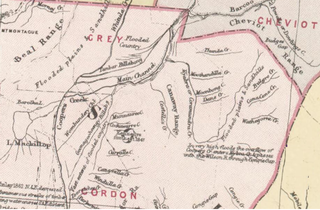
Sir Augustus Charles Gregory was an English-born Australian explorer and surveyor. Between 1846 and 1858 he undertook four major expeditions. He was the first Surveyor-General of Queensland. He was appointed a lifetime Member of the Queensland Legislative Council.

The Queensland Museum Kurilpa is the state museum of Queensland, dedicated to natural history, cultural heritage, science and human achievement. The museum currently operates from its headquarters and general museum in South Brisbane with specialist museums located in North Ipswich in Ipswich, East Toowoomba in Toowoomba, and in Townsville City in Townsville.

Haddon Corner is a heritage-listed site in Tanbar, Shire of Barcoo, Queensland, Australia. It is in outback Channel Country at South-West Queensland, on the border corner with South Australia. It was added to the Queensland Heritage Register on 9 November 2012.

Lands administrative divisions of Queensland refers to the divisions of Queensland used for the registration of land titles. There are 322 counties, and 5,319 parishes within the state. They are part of the Lands administrative divisions of Australia. Queensland had been divided into 109 counties in the nineteenth century, before the Land Act of 1897 subdivided many of these counties to 319. Some of the eastern counties remained the same, with most of the subdivisions occurring in the west and north. The current counties were named and bounded by the Governor in Council on 7 March 1901.

Carl Magnus Oscar Friström, generally known as Oscar Fristrom, was a portrait painter and art teacher born in Sweden, who had a substantial career in Queensland and South Australia, and was best known for his depictions of Aboriginal Australians.

Cameron Corner Survey Marker is a heritage-listed survey marker in the locality of Cameron Corner, Shire of Bulloo, Queensland, Australia. The survey marker is at the border corner of South-West Queensland with New South Wales and South Australia; it was established in 1880. It was added to the Queensland Heritage Register on 9 November 2012.

Poeppel Corner Survey Marker is a heritage-listed survey marker at Poeppel Corner on the border corner of Queensland, South Australia and Northern Territory. In Queensland it is with the locality of Birdsville in the Shire of Diamantina. It was added to the Queensland Heritage Register on 9 November 2012.

John Brewer Cameron was a geodetic surveyor in Australia. He is best known for his survey of the border between Queensland and New South Wales. He also surveyed part of the border between South Australia and Western Australia.
James Warner (1814–1891) was a pioneer surveyor in Queensland, Australia. Arriving at Moreton Bay penal colony in 1838, he was one of three surveyors who surveyed the area now Brisbane and its surrounding areas. He worked for 50 years in the Survey Office of Queensland, surveying and naming many towns and other features.

Kyabra County, Queensland is a cadastral division of Queensland and a County of the South Gregory District of south western Queensland.

Haddon County, Queensland is a cadastral division of Queensland, Australia. It is a county of the South Gregory District of far western Queensland. The county is divided into civil parishes.

Porchester County, Queensland is a cadastral division and a County of Queensland located on the Gulf of Carpentaria adjacent to the Northern Territory border. The county is divided into civil parishes.
Burrandilla County is a cadastral division of Queensland and a County of the Warrego Land District of south western Queensland. The county is divided into civil parishes.
Palmer County is a cadastral division of Queensland and a County of the Warrego Land District of southwestern Queensland.

Wyarra County, Queensland is a cadastral division of Queensland, Australia and a County of the Warrego Land District of remote western Queensland.

Gordon County is a cadastral division of Queensland, Australia and a County of the South Gregory District of remote western Queensland. The county is divided into civil parishes.

Kendall County is a County of Queensland located at 13.683°S 141.967°E on the Cape York Peninsula in remote far north of Queensland, Australia.
Gowan County, Queensland is a cadastral division of Queensland and a County of the Warrego Land District of southwestern Queensland in Australia.

Eyre County, Queensland is a cadastral division of North Gregory District of Western Queensland and a County of Queensland, Australia.
Yappar County, Queensland is a cadastral division of Burke District of northern Queensland and a County of Queensland, Australia.
















